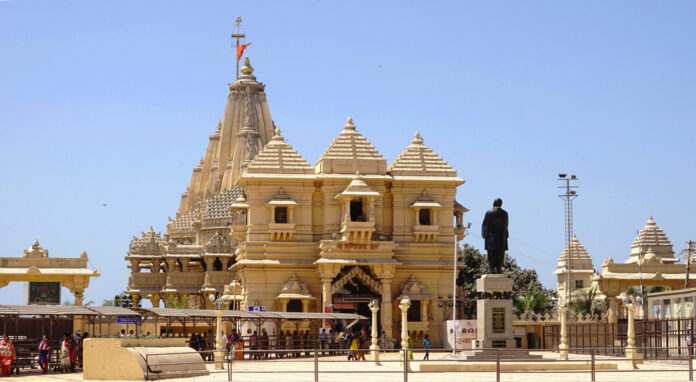Somnath Temple
The Somnath Temple, a magnificent shrine located in the western state of Gujarat, India, is one of the twelve Jyotirlinga shrines of Lord Shiva. Known for its historical and spiritual significance, the temple attracts millions of devotees and tourists every year. This article delves into the rich history, strategic location, timings, best time to visit, and detailed travel guide on how to reach the Somnath Temple.
Also Read: Best Famous Food of Gujarat
The Somnath Temple, often referred to as the “Eternal Shrine,” stands as a testament to India’s spiritual heritage and resilience. Overlooking the Arabian Sea, this temple is renowned for its impressive architecture and serene surroundings. The temple complex houses the main shrine dedicated to Lord Shiva and several smaller shrines and prayer halls.
Somnath Temple Key Features:
- Architectural Marvel: The temple’s design follows the Chalukya style of architecture, characterized by intricate carvings and sculptures.
- Spiritual Significance: It is believed to be the first among the twelve Jyotirlinga shrines of Shiva, symbolizing the god’s eternal light.
- Cultural Hub: Besides being a place of worship, the temple complex serves as a cultural center where various religious and cultural events are held throughout the year.
Somnath Temple History
The history of Somnath Temple is a saga of resilience and devotion. It has been destroyed and rebuilt several times due to invasions and natural calamities, each time rising from the ashes like a phoenix.
Historical Timeline:
- Ancient Origins: The temple’s origins trace back to ancient times, with references found in the Puranas and Mahabharata. The initial temple is believed to have been built by the Moon God, Somraj.
- Medieval Era: The temple faced several invasions, the most notable being by Mahmud of Ghazni in 1026 AD. Despite being plundered, it was rebuilt by Hindu kings.
- Modern Reconstruction: The current structure was reconstructed in 1951 under the initiative of Sardar Vallabhbhai Patel, reflecting the dedication of the Indian people to preserving their cultural heritage.
Key Events:
- First Destruction by Mahmud of Ghazni: In 1026 AD, the temple was destroyed, and its riches looted.
- Reconstruction Efforts: Rebuilt multiple times by different dynasties including the Paramaras, Chalukyas, and the Marathas.
- Modern Era: Post-independence, the temple was reconstructed with efforts led by Sardar Vallabhbhai Patel and other prominent leaders.
Somnath Temple Location
The Somnath Temple is situated in Prabhas Patan, near Veraval in the Saurashtra region of Gujarat.
Geographical Details:
- Coordinates: 20.8880° N, 70.4010° E
- Proximity to Major Cities: The temple is approximately 7 km from Veraval, 82 km from Junagadh, and around 400 km from Ahmedabad.
Nearby Attractions:
- Bhalka Tirth: Located nearby, this site is believed to be where Lord Krishna was mistakenly shot in the foot.
- Triveni Sangam: The confluence of three rivers – Hiran, Kapila, and Saraswati – is considered sacred and a must-visit spot near the temple.
Somnath Temple Timings
Visiting hours for the Somnath Temple are designed to accommodate the influx of devotees while ensuring a serene environment for worship.
Daily Schedule:
- Morning Darshan: 6:00 AM to 12:00 PM
- Afternoon Darshan: 12:30 PM to 6:30 PM
- Evening Darshan: 7:00 PM to 9:30 PM
Special Timings:
- Aarti: The three main Aarti timings are 7:00 AM, 12:00 PM, and 7:00 PM.
- Light and Sound Show: The temple also hosts a captivating light and sound show in the evening, narrating the history of Somnath.
Best Time to Visit Somnath Temple
While the temple can be visited year-round, certain seasons offer a more comfortable and enriching experience.
Seasonal Guide:
- Winter (October to March): This is the most pleasant time to visit, with mild temperatures ideal for sightseeing and outdoor activities.
- Monsoon (July to September): The temple and surrounding areas receive moderate to heavy rainfall, making it less ideal for travel.
- Summer (April to June): The temperatures can soar, making it quite hot, but it is still manageable if one prefers less crowded visits.
Festivals and Events:
- Mahashivratri: One of the most significant festivals celebrated with great fervor, attracting thousands of devotees.
- Kartika Purnima: Another auspicious time when special prayers and rituals are conducted.
How to Reach Somnath Temple
Reaching Somnath Temple is convenient due to its well-connected location. Here’s a detailed guide on how to reach the temple by various modes of transport.
By Air
- Nearest Airport: The nearest airport is Diu Airport, approximately 85 km away.
- Alternative Airports: Rajkot Airport (195 km) and Ahmedabad Airport (400 km) are other options.
- Connectivity: Regular flights are available from major cities like Mumbai, Ahmedabad, and Delhi.
- Travel Tip: From the airport, one can hire a taxi or take a bus to reach the temple.
By Train
- Nearest Railway Station: Veraval Railway Station is the closest, just 7 km from the temple.
- Major Trains: Several trains connect Veraval to major cities like Ahmedabad, Rajkot, and Mumbai.
- Travel Tip: From Veraval, local transport options like auto-rickshaws and taxis are readily available to reach the temple.
By Bus
- State Transport: Gujarat State Road Transport Corporation (GSRTC) operates regular buses to Somnath from various parts of the state.
- Private Buses: Several private operators also provide bus services from major cities. Somnath bus booking can be easily made on AbhiBus and here are some of the most traveled bus routes to Somnath.
- Ahmedabad to Somnath bus booking
- Bharuch to Somnath bus booking
- Surat to Somnath bus booking
- Ankleshwar to Somnath bus booking
- Travel Tip: Buses are a budget-friendly option, and one can choose between luxury, semi-luxury, and regular buses based on preference.
Local Transport:
- Auto-rickshaws and Taxis: Easily available around the temple area and from nearby towns.
- Car Rentals: Several agencies offer car rental services for a more comfortable and personalized travel experience.
Conclusion
The Somnath Temple is not just a place of worship but a beacon of India’s rich cultural and historical tapestry. Its awe-inspiring architecture, coupled with its storied past, makes it a must-visit destination for both devotees and history enthusiasts. Whether you are seeking spiritual solace or exploring India’s heritage, the Somnath Temple offers an experience like no other. Plan your visit with the detailed guide above to ensure a smooth and enriching journey to this eternal shrine.





